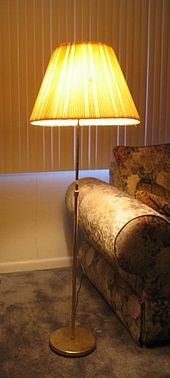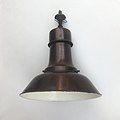lamp
When light , fachsprachlich occasionally Luminaire ( French for, lamp '), a device is known, in which a luminous means is permanently installed or can be installed and for the lighting used. In common parlance, luminaires are usually referred to as “lamps”, but in technical terms the lamp is the light source, for example the incandescent lamp or the fluorescent lamp . Colloquially, the term is also used to describe a clever person.
properties
Lights are available in different designs such as ceiling lights (as ceiling arches and crowns ), wall lights (as bar lights), table lights (such as desk lights ), floor lamps, street lights . They can be permanently installed or mobile. They can be operated electrically from the power grid , with accumulators or batteries , but also with gas .
In addition to the nominal voltage, electric lights with exchangeable light sources are specified for a maximum electrical output so as not to exceed the maximum current and maximum heating. Some lamps are not universally interchangeable (e.g. gas discharge lamps ). Such lights usually contain a base that is matched to the light source or the design of the light prevents the installation of unsuitable light sources. This applies, for example, to linear luminaires for fluorescent lamps, LHGL troughs , street lights or building and stadium lighting, but different light sources are often built in such a way that they fit into the same base and are therefore interchangeable (e.g. conventional incandescent lamps and LEDs or compact fluorescent lamps )
Further parameters of luminaires are their radiation characteristics ( directional characteristics ) and the minimal distance between flammable objects. The operating position is sometimes prescribed for both incandescent lamps and gas discharge lamps . Furthermore, the will LOR ( English Light Output Ratio - LOR ) specified for a lamp. It is the ratio of the output of a luminaire luminous flux to luminous flux of all lamps within this light. This value describes what proportion of the light emitted inside the luminaire can actually be used outside; typical values for conventional lights are between 50 and 70%; LED spotlights achieve values of over 90% due to the directional light emission. In addition, the components DLOR (Down Light Output Ratio) and ULOR (Upper Light Output Ratio) can be specified. This shows the distribution of the luminous flux of a luminaire in the upper and lower half-space.
In high-quality luminaires, reflectors (sometimes in conjunction with optical lens systems) are used to direct the light emitted by the illuminant as precisely as possible onto the surfaces to be illuminated, thereby reducing the energy consumption of lighting systems. Good cooling of the ballasts is also important , as this also reduces power consumption and significantly extends the life expectancy of the ballasts. The efficiency of lamps is also temperature-dependent, so that a luminaire should either cool the lamps used (through ventilation openings) or keep them warm (through closed luminaires) as required.
Old industrial lamp, design: Peter Behrens
Bedside lamp with lampshade
See also
- Applique
- Candlesticks
- Cable light
- chandelier
- Mosque traffic light
- Lantern
- Lantern
- Light sails
- Line light
- Wheel candlesticks
- Street light
- Cove light
- Solar light
Web links
Individual evidence
- ↑ "Light." In: Microsoft Encarta. 2009.
- ↑ Maria Grazia Chiaro (Red.): Duden, The Style Dictionary (= The Duden in 12 volumes . Volume 2 ). 8th edition. Dudenverlag, Mannheim / Leipzig / Vienna / Zurich, ISBN 3-411-04028-9 , p. 513 , column 1: "lamp" .




